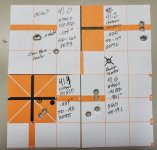Watched YouTube videos from Bangsteel Long Range Shooting School and thought I'd play a bit as I have two new loads to work up.
Rifle is 2A Xanthos 20" CF Proof with JP internals shooting 140ELDs over H4350 from 41.0-41.5 grains. All groups are 4 shots.
Result are pictured. I shot round robin style and only f-d up one target where I accidentally shot off target and had to overlay
My thoughts:
1. Scatter node at 41.5 grains?
2. Guy in the vid says optimal charge is 1.5% from scatter - in this case that would be the 41.0 charge and it grouped into nearly one hole after my clean bore shot (scrubbed the barrel last night).
3. Super interesting that velocity is nearly flat across the loads. Maybe 41.0 is a full burn in a 20" barrel?
Let me know your thoughts!
Rifle is 2A Xanthos 20" CF Proof with JP internals shooting 140ELDs over H4350 from 41.0-41.5 grains. All groups are 4 shots.
Result are pictured. I shot round robin style and only f-d up one target where I accidentally shot off target and had to overlay
My thoughts:
1. Scatter node at 41.5 grains?
2. Guy in the vid says optimal charge is 1.5% from scatter - in this case that would be the 41.0 charge and it grouped into nearly one hole after my clean bore shot (scrubbed the barrel last night).
3. Super interesting that velocity is nearly flat across the loads. Maybe 41.0 is a full burn in a 20" barrel?
Let me know your thoughts!
Attachments
Last edited:



